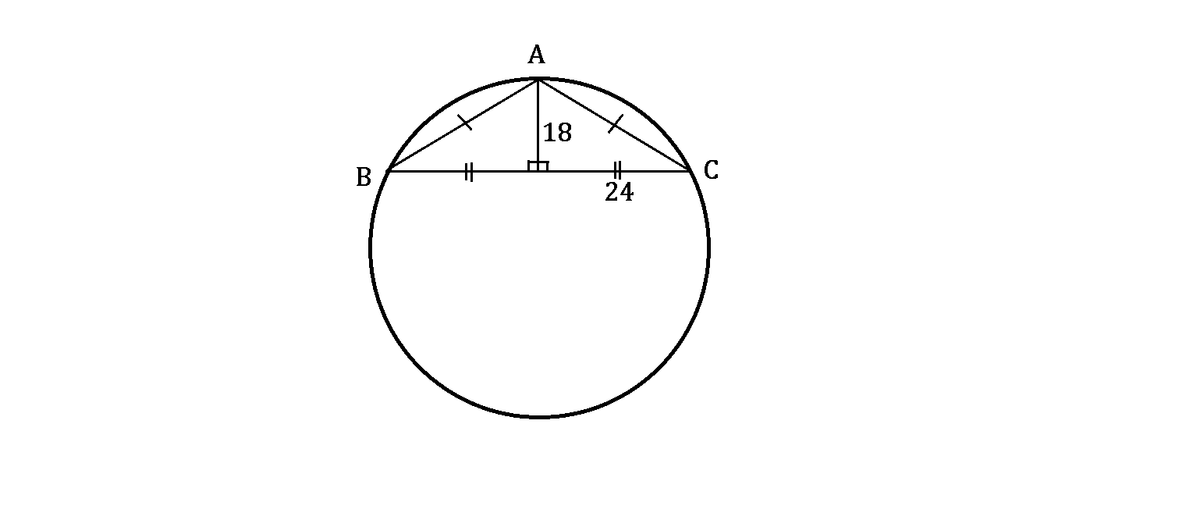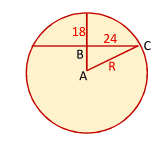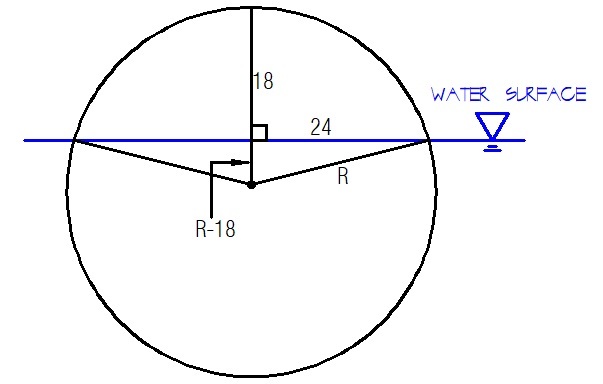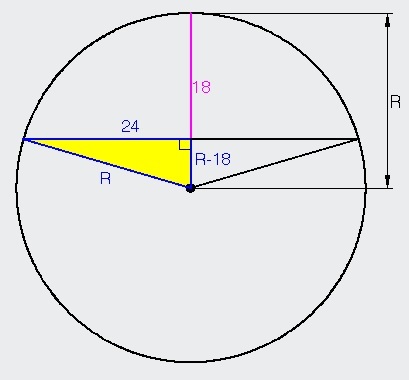Buoy Riddle
A spherical buoy is floating in the sea with an emerged cap part of height h = 1 8 cm and radius r = 2 4 cm , as shown below:
What is the radius of this buoy?
The answer is 25.
This section requires Javascript.
You are seeing this because something didn't load right. We suggest you, (a) try
refreshing the page, (b) enabling javascript if it is disabled on your browser and,
finally, (c)
loading the
non-javascript version of this page
. We're sorry about the hassle.
6 solutions
All I did was power theorem (Intersecting chords)
24+24=48 is the chord 18+x is the diameter of the sphere (Longest Chord)
24 24=18 x x=32 24+32= 50 (Diameter of the sphere) therefore, the radius is 25. :)
Relevant wiki: Extended Sine Rule

By constructing a 2-D inscribed triangle A B C in the spherical section, as shown above, we can calculate A C = 1 8 2 + 2 4 2 = 3 0 .
Then sin ∠ C = 3 0 1 8
Thus, by Sine Rule , sin ∠ C 3 0 = 1 8 3 0 2 = 2 R , where R is the radius of the circumcircle and, in this case, the sphere.
Hence, R = 6 2 3 0 2 = 2 5 .
The solution would be clearer if the picture would show the centre of the sphere (O) and R.
There are two alternative solutions, which might be easier to follow to many (as they rely more on conventional knowledge (taught in secondary schools)):
- The cosine rule can be applied regarding this AOC triangle, where AC = 30, cos A = 18/30 and AO = OC = R.
R 2 = R 2 + 3 0 2 − 2 × R × 3 0 × 3 0 1 8
0 = 9 0 0 − 3 6 R
R = 2 5
2.) If the base of the altitude on BC (drawn from A) is M, then AM = 18.
Since OA = R, OM = OA - AM = R - 18
On the other hand, by applying Pythagoras' theorem regarding the MOC triangle:
OM = \sqrt { OC^2 - MC^2 } = \sqrt { R^2 - 24^2 }
Hence:
R − 1 8 = R 2 − 2 4 2
R 2 − 3 6 R + 3 2 4 = R 2 − 5 7 6
9 0 0 = 3 6 R
R = 2 5
 In triangle
A
B
C
In triangle
A
B
C
R 2 = ( R − 1 8 ) 2 + 2 4 2
Solution is R = 2 5 .
This is the best explanation for the question.
Relevant wiki: Pythagorean Theorem
 By pythagorean theorem, we have
By pythagorean theorem, we have
R 2 = ( R − 1 8 ) 2 + 2 4 2
R 2 = R 2 − 3 6 R + 3 2 4 + 5 7 6
3 6 R = 9 0 0
R = 2 5
 Applying
pythagorean theorem
on the yellow right triangle, we have
Applying
pythagorean theorem
on the yellow right triangle, we have
R 2 = ( R − 1 8 ) 2 + 2 4 2
R 2 = R 2 − 3 6 R + 3 2 4 R + 5 7 6
3 6 R = 9 0 0
R = 2 5
If we drop a line from the top of the ball T to the bottom B and call the point where the radius meets the sphere A and the point where the radius meets the diameter we've drawn C then the angle TAB = 90 degrees. tan of angle TAC = 18 / 24 = .75 so angle TAC = 36.8699 degrees. angle CAB = 90 - TAC = 53.1301 degrees and 24 times tan (53.1301) = 32 for line CB so diameter TB = TC + CB = 18 + 32 and radius = 25
Solution Using Pythagorean Theorem:
R 2 = 2 4 2 + ( R − 1 8 ) 2
R 2 = 5 7 6 + R 2 − 3 6 R + 3 2 4
R 2 = 9 0 0 + R 2 − 3 6 R
3 6 R = 9 0 0
R = 2 5 answer